World Roundup
July/August 2014


-
 DOMINICAN REPUBLIC: La Isabela was the first permanent, non-Viking European colony in the New World. Founded in 1494 by Christopher Columbus and more than 1,000 settlers, the town was haunted by sickness and death. Twenty-seven skeletons excavated from the site in the 1980s and 1990s were recently reexamined and showed that most were afflicted with severe scurvy, caused by vitamin C deficiency. The resulting fatigue and pain likely contributed to the colony’s dismal prospects—it lasted just four years.—SAMIR S. PATEL
DOMINICAN REPUBLIC: La Isabela was the first permanent, non-Viking European colony in the New World. Founded in 1494 by Christopher Columbus and more than 1,000 settlers, the town was haunted by sickness and death. Twenty-seven skeletons excavated from the site in the 1980s and 1990s were recently reexamined and showed that most were afflicted with severe scurvy, caused by vitamin C deficiency. The resulting fatigue and pain likely contributed to the colony’s dismal prospects—it lasted just four years.—SAMIR S. PATEL -
 MEXICO: Plant scientists have used four approaches—ecological, linguistic, genetic, and archaeological—to zero in on the home region of the first domesticated chili peppers. All lines of evidence, including the range of Proto-Otomanguean, the oldest language thought to have a word for chili peppers, and the oldest known archaeological pepper remains, converge on north- and central-eastern Mexico. No wonder the mole sauce in Puebla is so good.—SAMIR S. PATEL
MEXICO: Plant scientists have used four approaches—ecological, linguistic, genetic, and archaeological—to zero in on the home region of the first domesticated chili peppers. All lines of evidence, including the range of Proto-Otomanguean, the oldest language thought to have a word for chili peppers, and the oldest known archaeological pepper remains, converge on north- and central-eastern Mexico. No wonder the mole sauce in Puebla is so good.—SAMIR S. PATEL -
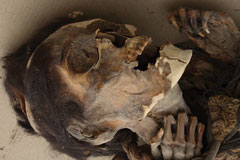 CHILE: Inca and Chinchorro mummies have long shown evidence of exposure to naturally occurring arsenic. Scientists applied sophisticated optical tests to hair from a 1,000- to 1,500-year-old mummy to determine how she had been exposed to the toxic element. Arsenic suffused the hair all the way through, indicating it had been ingested in contaminated groundwater, rather than deposited from surrounding soil after burial. Groundwater in some parts of the Atacama Desert is still tainted with arsenic today.—SAMIR S. PATEL
CHILE: Inca and Chinchorro mummies have long shown evidence of exposure to naturally occurring arsenic. Scientists applied sophisticated optical tests to hair from a 1,000- to 1,500-year-old mummy to determine how she had been exposed to the toxic element. Arsenic suffused the hair all the way through, indicating it had been ingested in contaminated groundwater, rather than deposited from surrounding soil after burial. Groundwater in some parts of the Atacama Desert is still tainted with arsenic today.—SAMIR S. PATEL -
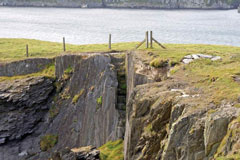 IRELAND: Steps and niches for candles or lanterns cut into the rocky coast near Baltimore, County Cork, may point to a hive of pirates and smugglers. The area was host to a pirate alliance that was defeated by a Dutch fleet in 1614. Underwater archaeologists hope that the rocky steps, one set of which leads to a cavern accessible by water (perfect for illicit activity), indicate that pirate ships, and perhaps the entire alliance fleet, might be in nearby waters.—SAMIR S. PATEL
IRELAND: Steps and niches for candles or lanterns cut into the rocky coast near Baltimore, County Cork, may point to a hive of pirates and smugglers. The area was host to a pirate alliance that was defeated by a Dutch fleet in 1614. Underwater archaeologists hope that the rocky steps, one set of which leads to a cavern accessible by water (perfect for illicit activity), indicate that pirate ships, and perhaps the entire alliance fleet, might be in nearby waters.—SAMIR S. PATEL -
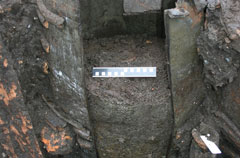 DENMARK: Digs in Odense have exposed the town’s medieval history—and bouquet. Among the finds are a barrel-lined well connected to a building thought to have been a brewery. Wood at the site, including two more barrels that had been used as latrines, is well preserved. The privies are going to be troves of information on medieval diet, hygiene, and health. According to archaeologists, they also preserve the smell of the Middle Ages.—SAMIR S. PATEL
DENMARK: Digs in Odense have exposed the town’s medieval history—and bouquet. Among the finds are a barrel-lined well connected to a building thought to have been a brewery. Wood at the site, including two more barrels that had been used as latrines, is well preserved. The privies are going to be troves of information on medieval diet, hygiene, and health. According to archaeologists, they also preserve the smell of the Middle Ages.—SAMIR S. PATEL -
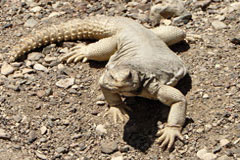 SAUDI ARABIA: According to historical sources, people have long eaten Arabian spiny-tailed lizards. According to tradition, Muhammad did not eat them himself, but did not condemn the practice. At the site of al-Yamâma, archaeologists uncovered remains of lizards among those of other food animals, and at least one bone has a cut mark. The lizard bones appear in early layers (4th to 7th century, before and just after the establishment of Islam) and continue to the 18th century. The reptiles remain a source of protein and fat in some parts of the harsh desert today.—SAMIR S. PATEL
SAUDI ARABIA: According to historical sources, people have long eaten Arabian spiny-tailed lizards. According to tradition, Muhammad did not eat them himself, but did not condemn the practice. At the site of al-Yamâma, archaeologists uncovered remains of lizards among those of other food animals, and at least one bone has a cut mark. The lizard bones appear in early layers (4th to 7th century, before and just after the establishment of Islam) and continue to the 18th century. The reptiles remain a source of protein and fat in some parts of the harsh desert today.—SAMIR S. PATEL -
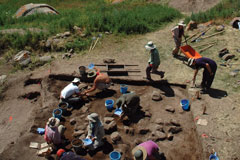 KAZAKHSTAN: Bands of nomadic herders were stepping stones for the spread of crops between opposite ends of Asia 5,000 years ago—the seeds of what would become the Silk Road. Archaeobotanical analysis at their seasonal camps shows that the pastoralists had access to both wheat from Central and Southwest Asia and millet from East Asia. The seeds were found only among cremation burials, so they might have served some ritual purpose. The nomads’ own agricultural tradition appears to have started 1,500 years later.—SAMIR S. PATEL
KAZAKHSTAN: Bands of nomadic herders were stepping stones for the spread of crops between opposite ends of Asia 5,000 years ago—the seeds of what would become the Silk Road. Archaeobotanical analysis at their seasonal camps shows that the pastoralists had access to both wheat from Central and Southwest Asia and millet from East Asia. The seeds were found only among cremation burials, so they might have served some ritual purpose. The nomads’ own agricultural tradition appears to have started 1,500 years later.—SAMIR S. PATEL -
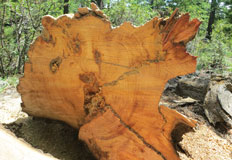 MONGOLIA: Adverse climate changes are often cited in the declines of civilizations—see the Indus, Ancestral Pueblo, Bronze Age Mesopotamia, Classic Maya, Tang Dynasty, and more. Surely good weather also made a mark on history. According to a study of tree rings in gnarled, ancient Siberian pines, Mongolia was pleasant—warm and wet—from 1211 to 1230, coinciding with the rise of Genghis Khan. More rain would have meant more grass, which meant more livestock, wealth, and warhorses—the engines of the Mongol army.—SAMIR S. PATEL
MONGOLIA: Adverse climate changes are often cited in the declines of civilizations—see the Indus, Ancestral Pueblo, Bronze Age Mesopotamia, Classic Maya, Tang Dynasty, and more. Surely good weather also made a mark on history. According to a study of tree rings in gnarled, ancient Siberian pines, Mongolia was pleasant—warm and wet—from 1211 to 1230, coinciding with the rise of Genghis Khan. More rain would have meant more grass, which meant more livestock, wealth, and warhorses—the engines of the Mongol army.—SAMIR S. PATEL -
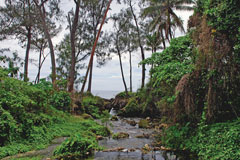 VANUATU: Most of what is known about the Lapita, the culture that colonized the remote South Pacific 3,000 years ago, comes from pots. Human remains are rare. Researchers have conducted isotopic studies on remains from the largest known Lapita cemetery—68 burials—for insight into their diet. They found that it was some time before crops were established as a significant part of the menu. The earliest colonists relied instead on a forager’s diet of fish, turtles, fruit bats, and free-range but domesticated pigs and chickens.—SAMIR S. PATEL
VANUATU: Most of what is known about the Lapita, the culture that colonized the remote South Pacific 3,000 years ago, comes from pots. Human remains are rare. Researchers have conducted isotopic studies on remains from the largest known Lapita cemetery—68 burials—for insight into their diet. They found that it was some time before crops were established as a significant part of the menu. The earliest colonists relied instead on a forager’s diet of fish, turtles, fruit bats, and free-range but domesticated pigs and chickens.—SAMIR S. PATEL
Advertisement
IN THIS ISSUE
Advertisement

Recent Issues
-
 May/June 2024
May/June 2024
-
 March/April 2024
March/April 2024
-
 January/February 2024
January/February 2024
-
 November/December 2023
November/December 2023
-
 September/October 2023
September/October 2023
-
 July/August 2023
July/August 2023
-
 May/June 2023
May/June 2023
-
 March/April 2023
March/April 2023
-
 January/February 2023
January/February 2023
-
 November/December 2022
November/December 2022
-
 September/October 2022
September/October 2022
-
 July/August 2022
July/August 2022
-
 May/June 2022
May/June 2022
-
 March/April 2022
March/April 2022
-
 January/February 2022
January/February 2022
-
 November/December 2021
November/December 2021
-
 September/October 2021
September/October 2021
-
 July/August 2021
July/August 2021
-
 May/June 2021
May/June 2021
-
 March/April 2021
March/April 2021
-
 January/February 2021
January/February 2021
-
 November/December 2020
November/December 2020
-
 September/October 2020
September/October 2020
-
 July/August 2020
July/August 2020
-
 May/June 2020
May/June 2020
-
 March/April 2020
March/April 2020
-
 January/February 2020
January/February 2020
-
 November/December 2019
November/December 2019
-
 September/October 2019
September/October 2019
-
 July/August 2019
July/August 2019
-
 May/June 2019
May/June 2019
-
 March/April 2019
March/April 2019
-
 January/February 2019
January/February 2019
-
 November/December 2018
November/December 2018
-
 September/October 2018
September/October 2018
-
 July/August 2018
July/August 2018
-
 May/June 2018
May/June 2018
-
 March/April 2018
March/April 2018
-
 January/February 2018
January/February 2018
-
 November/December 2017
November/December 2017
-
 September/October 2017
September/October 2017
-
 July/August 2017
July/August 2017
-
 May/June 2017
May/June 2017
-
 March/April 2017
March/April 2017
-
 January/February 2017
January/February 2017
-
 November/December 2016
November/December 2016
-
 September/October 2016
September/October 2016
-
 July/August 2016
July/August 2016
-
 May/June 2016
May/June 2016
-
 March/April 2016
March/April 2016
-
 January/February 2016
January/February 2016
-
 November/December 2015
November/December 2015
-
 September/October 2015
September/October 2015
-
 July/August 2015
July/August 2015
-
 May/June 2015
May/June 2015
-
 March/April 2015
March/April 2015
-
 January/February 2015
January/February 2015
-
 November/December 2014
November/December 2014
-
 September/October 2014
September/October 2014
-
 July/August 2014
July/August 2014
-
 May/June 2014
May/June 2014
-
 March/April 2014
March/April 2014
-
 January/February 2014
January/February 2014
-
 November/December 2013
November/December 2013
-
 September/October 2013
September/October 2013
-
 July/August 2013
July/August 2013
-
 May/June 2013
May/June 2013
-
 March/April 2013
March/April 2013
-
 January/February 2013
January/February 2013
-
 November/December 2012
November/December 2012
-
 Sep/Oct 2012
Sep/Oct 2012
-
 September/October 2012
September/October 2012
-
 July/August 2012
July/August 2012
-
 May/June 2012
May/June 2012
-
 March/April 2012
March/April 2012
-
 January/February 2012
January/February 2012
-
 November/December 2011
November/December 2011
-
 September/October 2011
September/October 2011
-
 July/August 2011
July/August 2011
-
 May/June 2011
May/June 2011
-
 March/April 2011
March/April 2011
-
 January/February 2011
January/February 2011
Advertisement






